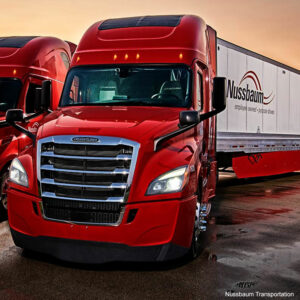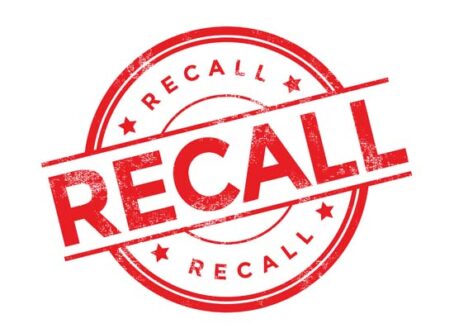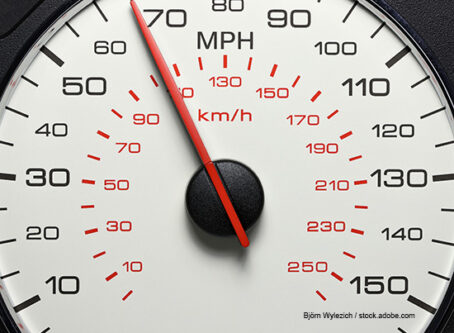Diesel ‘downspeeding’ doesn’t increase brake wear, TMC panel says
“Downspeeding” – the practice of cruising at low engine speeds to save fuel – usually doesn’t cause added brake wear, even though engines seem to be running too slowly to effectively use the power of engine retarders.
That’s the conclusion of a panel of brake and driveline experts speaking at an industry meeting this week. Among other things, they said engine retarders now work better at lower revs than they did before. They were backed by a fleet manager who said brake wear in his company’s tractors had not increased after adopting downspeeding.
The concept works because downsped diesels are usually paired with automated manual transmissions, which can downshift quickly to gain both retarding and propulsion output when needed, said Kris Ptasznik, heavy-duty on-highway product manager for Columbus, Ind.-based Cummins Inc. Low-speed engines use less fuel because pistons and other internal parts run fewer cycles in a given distance, reducing parasitic friction. A downside is sometimes sluggish performance.
The session was among those at the Technology & Maintenance Council’s fall meeting on Sept. 24-29 in Cleveland, Ohio. TMC is part of the American Trucking Associations.
Prized fuel savings
Downsped diesels first appeared more than 40 years ago as a reaction to fuel shortages and high per-gallon prices, but weren’t successful. They reappeared about 2007 when truck builders, using experience gained in Europe and satisfied with their own tests, introduced them as options.
Aimed primarily at fleets whose leaders prized dollar savings from reduced fuel consumption, the engines were designed to operate continuously as low as 1,100 rpm, with some versions set at 1,200 and 1,300 rpm, and offered fuel savings of several percent. Ratios in transmissions and differentials were changed to support the low-speed engines; a typical rear-axle ratio went from 3.08 in 2007 to as low as 2.16 in 2020, Ptasznik said.
Engine retarders supplement a truck’s service brakes, which use friction produced by drum linings or disc pads, explained Joe Kay, chief braking systems engineer for Troy, Mich.-based Meritor, a prominent maker of brakes, axles and other chassis products. Engineers at truck builders design every truck’s braking system to repeatedly slow and stop the vehicle based on its intended weight and brake type, and to meet federal stopping requirements outlined in Federal Motor Vehicle Safety Standard 121. The truck will operate safely, and any added braking power and reduction in service-brake wear gained from an engine retarder is a “bonus.”
Jacobs Engine Brakes, now used on most diesels, get their power from altering valve action so an engine becomes an air pump, putting a strong drag on the drivetrain. Historically Jake Brakes develop greater braking force at higher rpm. But Jacobs has redesigned its retarder to work more strongly at lower rpm, Ptasznik said, so making an engine rev to governed speed, at 2,000 to 2,100, is not needed except on steep downgrades. Predictive cruise control, a feature offered in some form by most truck builders, uses GPS mapping data to understand when downgrades are imminent and switch on an engine brake about 3 mph sooner than a system otherwise might. Another method is to use terrain data captured on previous runs over given stretches of highway to “learn” the routes.
Downspeeding saves fuel, engine wear
Hudson, Ill.-based Nussbaum Transportation has embraced the downspeeding concept, and it is helping to save fuel as designed, said Justin Worden, the manager who said brake wear has not suffered. He credited automated transmissions’ ability to downshift to increase engine speed and retard power for making that possible. Low-speed engines also suffer less wear of internal parts and emit less carbon dioxide, and motor oil stays cleaner, allowing the fleet to extend its oil-change interval from 50,000 miles to 75,000.

The only downside Nussbaum has seen are driver complaints of “low torque,” and the fleet counters that through additional training – “teaching drivers how to enjoy the system,” as he put it. Drivers are instructed to operate in a road-speed range where the truck can be entirely controlled through the powertrain, Worden said. If drivers find themselves using service brakes to control road speed, they should slow to a speed range where they are no longer needed, except for downgrades and traffic conditions, Worden said.
What about exhaust aftertreatment devices?
An audience member asked if cooler exhaust from slow-running engines impeded the operation of exhaust aftertreatment devices that need heat to work properly. Cummins’ Ptasznik said that more heat is actually sent to the oxygen catalyst and diesel particulate filter. One way is to let the engine go back to idle on level or slightly downhill portions of a highway – another function of an automated transmission – so a small amount of fuel is burned in the cylinders, generating heat. If the engine was allowed to coast in gear, fuel would be turned off and the exhaust would cool. Overall, the engine still saves fuel in the more extended times when it is working to propel the truck.
Automated transmissions also upshift to save engines while on steeper downgrades, another attendee noted. Wouldn’t that allow the truck to run away on downgrades? No, because the engine will stay intact, and its retarder will still provide some braking power, Ptasznik said. He then commented, “I’d rather have some engine braking than none at all,” which would happen if the engine blew, along with the retarder. Automated transmissions upshift by 2,200 rpm under such circumstances.
TMC’s fall meeting, which included SuperTech competition among more than a hundred technicians, was scheduled to wrap up Thursday, Sept. 29. LL









